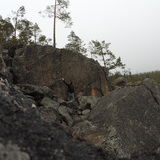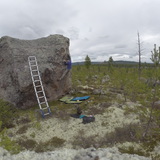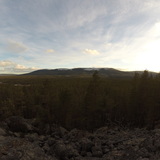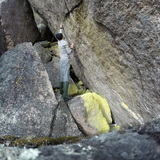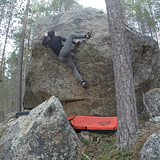Skjolmberget is the crown jewel among the bouldering areas of Härjedalen province. Located in the Ljusnan river valley by the confluence of Ljusnan and its tributary Rånden, this area is surrounded on two sides by water and three sides by mountains. The grand Sonfjället mountain massif (elevation 1277 m) lies straight to the west and is clearly visible from a few of the boulders making up a nice backdrop, especially on warm sunny spring days when the mountain is still covered in snow. The amount of established problems exceeded 100 in 2021 and keeps growing. The current grade range is 3 to 7A+ although about 80 projects, most of them 7A and harder, have already been cleaned and with many more still untouched. Here you can find anything from two meter lowballs to ten meter highballs. Skjolmberget bouldering area is made up from three characteristically distinct sectors bordering each other.
-Hygget is a large sector with boulders dispersed on sandy moraine near the shore of the river Ljusnan. The forest in this sector consists of clearings of various age and is almost exclusively made up of young pine trees. Most boulders are found in an open setting and dry relatively quickly after rain. Landings are generally flat and quite soft due to the sandy soil. Approaches are short and easy.
-Åsen sector is found along a ridge linking sector Hygget with Skjolmberget mountain. The environment here is old-growth forest that has probably only been sparingly logged in the past and as a result the pines here are bigger and give more shade. The boulders here are generally larger and the concentration is higher than in Hygget sector but the approach is tougher. Despite the more rocky and rough terrain many boulders still feature good landings.
-Rasbranten is a large talus field on the south side of Skjolmberget mountain connected to Åsen sector in the east. As it is a south-facing talus field there are few trees and the boulders dry quickly. It can also offer somewhat of a respite during the mosquito season from mid-June to mid-August. The boulders are of mixed size but seem to grow larger the further west you go. Most landings here are quite rough but exceptions can be found. This sector is by no means child-friendly and even bouldering alone here is probably ill-advised.
Geologically the area sits upon the westernmost extent of the Rätan granite batholith. Rätan granite is a porphyritic granite group and the boulders of Skjolmberget are either talus blocks or glacial erratics made up of this rock type. A climbing visitor to the area will soon notice however that the granite can be divided into two texture types, one more common mid to coarse-grained granite and another smooth and glassy granite similar to quartzite. The latter gives the area somewhat of an extra dimension compared to other areas on the Rätan batholith.
Quality-wise the rock is good, sometimes excellent even. Few holds break and rather little cleaning is needed for new boulders. Generally the boulders are featured, most-so in Rasbranten sector and least-so at Åsen but, as is often the case with granite, individual boulder problems are quite singular and easily distinguished. Crimps constitute the most common hold type but are seldomly very sharp. Some surfaces may be quite coarse but usually holds offer good friction rather than razor crystals.
The spring climbing season starts in mid-April and ends in mid-June as the bugs start to become numerous. By mid-August the bug situation becomes tolerable and the fall season begins. The fall season ends when the first snow falls, usually somewhere between mid-October to early November. During the mosquito season climbing is still enjoyable on windy days and around midsummer you will not be pestered by the bugs if you climb during the nighttime which is possible even without headlamp. Night climbing will also offer cooler temperatures although humidity rises.
The climate for Skjolmberget is like much of central Scandinavia east of the mountain chain. A cold snowy winter season is followed by a mild, dry and windy spring offering by far the best season to go bouldering here. Already by mid-April day length is almost 15 hours with the sun setting at around 8:30 pm. The predominant westerly winds conveniently create a rainshadow at the eastern side of the mountain chain resulting in an average annual precipitation of around 550 mm. Due to the central location on the Scandinavian peninsula the climate is somewhat continental meaning heat waves with temperatures around 30ºC are not too uncommon in summertime. However this also means that nighttime temperatures can on rare occasions fall close to freezing even in the summer. The fall season is more humid with shorter days but the dropping temperatures can again offer amazing climbing conditions. In October and November, boulders may be wet in the morning hours even if there was no rain during the night.
In addition to climbing the area around Skjolmberget offers other activities. During the month of April skiing is still possible and there are several ski resorts quite close-by. In the summer, packrafting down Rånden river is a very pleasant experience with several rapids along the way. Water flow is best before August. If you want to go for a swim or just relax there are several sandy beaches in the area but the best one is found just north of Ransjö settlement. Fishing is another popular activity, especially in the various small lakes sprinkled across the area or in the rapids by the small bridge over Ljusnan river. Many of the fishing spots are marked with signs and some feature shelters, benches and fire rings. Nice hiking is readily available with several trails nearby and also within the nearby Sonfjället National Park. Sonfjället is home to a rather large population of Eurasian brown bears and safaris are at times organised in this area. It is prudent when camping to be "bear aware" as signs of bear presence is quite common at Skjolmberget. The topo author has however only encountered bears in the area on one occasion. Another animal of concern is the common European adder which tends to enjoy the southern slopes of Skjolmberget, especially during spring. They have been encountered here at several occasions so be mindful when walking around.
The closest settlements to Skjolmberget are Ransjö and Linsell. Ransjö is located just across Ljusnan and is where the small bridge across the river is accessed. Linsell is only a few minutes drive away from Ransjö and has a small convenience store, a gas pump and a restaurant. The nearest town is Sveg, some 30 minutes drive away, where a larger selection of restaurants and shops may be found. Sveg also has a small airport with flight connections six days a week to Stockholm Arlanda.
The Swedish right of public access allows for camping for a couple of days with a party size up to three tents at any site as long as it is not too close to houses or cottages. This of course presupposes no littering and keeping noise levels at a minimum. All the boulders are located on land owned by forestry companies. There are no close-by hotels, inns or campings and, while there is a bus stop in Ransjö, public transport is not a recommended option for climbing at Skjolmberget.
